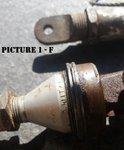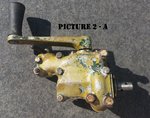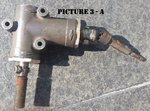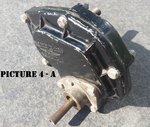JakobVonBismarck
Recruit
Hey everyone,
Recently I purchased a box full of unidentified aircraft parts in which the previous owner had obtained the parts from a RAAF garbage dump to use in scientific equipment and such after the war, so some of the parts are a bit chopped and hacked up.
I was just wondering if anybody could possibly identify the type of aircraft/s that these parts could have come off of, and what they would have been used for, I am considering that they most likely will be off of RAAF Pacific aircraft such as Beaufort's, Beaufighters and possibly P-51's. The parts all have a similar colour scheme of a khaki/army green colour whilst some parts like the bar and handle are painted in a yellow bomber sort of scheme.
Please find below the pictures of the items in which I seek help identifying, most parts do not have any serial numbers on them, but the parts that do I have attached photos of them below. I didn't take any other photos of the other items in the box as they are mainly chopped up aircraft motor parts turned into drills and such.
Any help or assistance would be greatly appreciated in identifying these aircraft parts.
Firstly, these two strange metal bars. The top metal bar measures 70cms in length, the smaller limb attached to the right can pivot back and forth whilst it can also spin around on ball bearings. The bottom bar is quite similar but has a small locking pin attached with rope to it. Possibly to hold it in place or grant accessibility in maintenance checks?


Picture 1 - D: Has the serial number JI1K899A10 imprinted on the top piece from Picture 1 - A




Next up is a yellow crank handle that came with a plaque which reads, CRANK EXTENSION BOMB DOORS FLAP. The crank makes clicking noises when rotated, and the direction of rotation can be changed by flicking the silver lever pointed out in the photo, which then spins a small tube which can most likely attach to something. A large number of screws are attached to the main body suggesting that this piece may have been attached to something heavy duty or bolted to the inside of a cockpit?


Closeup of the bottom of the rotating metal piece controlled by the crank.


The next strange piece is painted an army green colour with a piece of metal which has the ability to gimbal and spin on one end, and a large screw piece which looks like it may have attached to something heavy duty or structural. On the main body it is stamped with M-378-C and on the other side, 44A. Direction arrows are embossed suggesting the movement of the pieces?


Next up is a black gearbox which measures 16cm in length and has two rotating bolts either side. One side you have to spin really fast in order to get the bolt on the other side to spin, i'm guessing maybe a starter motor for an aircraft, or something motor related? On one side the words, GEAR BOX TYPE JH-1045 - JAHCO - JACK & HEINTZ, INC. CLEVELAND, OHIO, USA are embossed into the metal.


Next up are two strange looking but most likely not important pieces, one painted a khaki green and the other seems to resemble a venturi tube (15cm long) with a ring of red paint around the outside.

And lastly a yellow painted hollow support piece measuring 65 cm in length which looks like it may have been involved in something lightly structural in the aircraft, most likely the fuselage or possibly landing gear? The numbers 204477 are engraved in the end of the piece near the hole at the end.

Any help in identifying these pieces and possibly what aircraft they're off and their use would be greatly appreciated and all suggestions are welcome!
Thanks
Jacob
Recently I purchased a box full of unidentified aircraft parts in which the previous owner had obtained the parts from a RAAF garbage dump to use in scientific equipment and such after the war, so some of the parts are a bit chopped and hacked up.
I was just wondering if anybody could possibly identify the type of aircraft/s that these parts could have come off of, and what they would have been used for, I am considering that they most likely will be off of RAAF Pacific aircraft such as Beaufort's, Beaufighters and possibly P-51's. The parts all have a similar colour scheme of a khaki/army green colour whilst some parts like the bar and handle are painted in a yellow bomber sort of scheme.
Please find below the pictures of the items in which I seek help identifying, most parts do not have any serial numbers on them, but the parts that do I have attached photos of them below. I didn't take any other photos of the other items in the box as they are mainly chopped up aircraft motor parts turned into drills and such.
Any help or assistance would be greatly appreciated in identifying these aircraft parts.
Firstly, these two strange metal bars. The top metal bar measures 70cms in length, the smaller limb attached to the right can pivot back and forth whilst it can also spin around on ball bearings. The bottom bar is quite similar but has a small locking pin attached with rope to it. Possibly to hold it in place or grant accessibility in maintenance checks?
Picture 1 - D: Has the serial number JI1K899A10 imprinted on the top piece from Picture 1 - A




Next up is a yellow crank handle that came with a plaque which reads, CRANK EXTENSION BOMB DOORS FLAP. The crank makes clicking noises when rotated, and the direction of rotation can be changed by flicking the silver lever pointed out in the photo, which then spins a small tube which can most likely attach to something. A large number of screws are attached to the main body suggesting that this piece may have been attached to something heavy duty or bolted to the inside of a cockpit?


Closeup of the bottom of the rotating metal piece controlled by the crank.


The next strange piece is painted an army green colour with a piece of metal which has the ability to gimbal and spin on one end, and a large screw piece which looks like it may have attached to something heavy duty or structural. On the main body it is stamped with M-378-C and on the other side, 44A. Direction arrows are embossed suggesting the movement of the pieces?


Next up is a black gearbox which measures 16cm in length and has two rotating bolts either side. One side you have to spin really fast in order to get the bolt on the other side to spin, i'm guessing maybe a starter motor for an aircraft, or something motor related? On one side the words, GEAR BOX TYPE JH-1045 - JAHCO - JACK & HEINTZ, INC. CLEVELAND, OHIO, USA are embossed into the metal.


Next up are two strange looking but most likely not important pieces, one painted a khaki green and the other seems to resemble a venturi tube (15cm long) with a ring of red paint around the outside.

And lastly a yellow painted hollow support piece measuring 65 cm in length which looks like it may have been involved in something lightly structural in the aircraft, most likely the fuselage or possibly landing gear? The numbers 204477 are engraved in the end of the piece near the hole at the end.

Any help in identifying these pieces and possibly what aircraft they're off and their use would be greatly appreciated and all suggestions are welcome!
Thanks
Jacob
Last edited:








